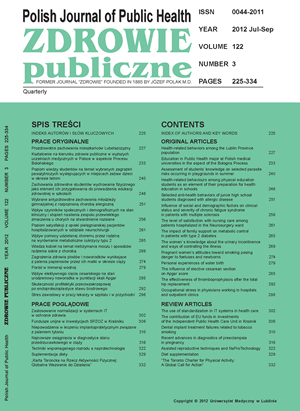Assessment of students’ knowledge on selected parasite risks occurring in playgrounds in summer
DOI:
https://doi.org/10.12923/j.0044-2011/122/3/a.03Keywords:
children’s health, parasitoses, playgrounds, students’ knowledgeAbstract
Introduction. Public sandboxes are defiled by dog, cat and children’s faeces that can contain ova and other developmental forms of parasites: Giardia lamblia, Toxoplasma gondii, Toxocara canis, Toxocara cati, Enterobius vermicularis, Ascaris lumbricoides.
Aim. The aim of the study was to assess the state of knowledge regarding the risk of infestation with developmental forms of parasites in children, which may occur in public playgrounds in the aestival season, in students of the Medical University of Lodz.
Material and methods. Data from questionnaires filled in by 200 randomly drawn extramural students of the Medical University of Lodz comprised the material for the study.
Results. The problem of parasitic diseases occurrence in humans was better known in respondents living in big cities. The playgrounds were indicated most frequently by students from small towns. As the majority of respondents indicated, the parasitic diseases of the intestinal tract were caused by the lack of personal hygiene. Only 30% out of the students knew that children in the sandboxes could be infested with Toxocara canis and Toxocara cati. More than half were aware of the risk of Giardia lamblia infestation within the sandbox. However, two thirds of them knew that the cat faeces contain Toxoplasma gondii oocysts, which can cause toxoplasmosis. Few students remembered that undercooked or raw meat can comprise developmental forms of Toxoplasma gondii. Out of the surveyed students 13.4% from rural areas, 12.6% from small towns, and 12.0% from big cities were cognizant of the zoonotic disease prevention in children. Respectively, 84.6%, 83.3% and 92.2% knew that babesiosis and tick-borne ence-phalitis can be transmitted by ticks, though only 1/3 of them were acquainted with methods of protecting the skin from tick bites.
Conclusions. The students’ knowledge on the risk of infestation with developmental forms of parasites in children playing in the sandbox was mediocre. The respondents presented a low awareness of parasitic disease prevention. Female students were more aware of the consequences of leaving the animal faeces in the sandboxes. The respondents from rural areas showcased inferior knowledge of the possibilities of infestation with T. gondii in children consuming undercooked or raw meat.
References
1. Bitkowska E, Wnukowska N, Wojtyniak B, Dzbeński TH. Analiza występowania pasożytów jelitowych u dzieci klas pierwszych w latach 2002/03. Przegląd Epidemiol. 2004;58:295-302.
2. Ołdakowska A, Popielska J, Marczyńska M, Szczepańska-Putz M, Dobos S. Wybrane choroby pasożytnicze u dzieci – rozpoznanie i leczenie. Przew Lek. 2003; 6(11/12):60-9.
3. Niedworok M, Sordyl B, Płaneta-Małecka I, Borecka A, Gawor J, Małecka-Panas E. Obraz kliniczny toksokarozy u dzieci w województwie łódzkim. Przew Lek. 2008:2:83-7.
4. Figlerowicz M. Borelioza – pamiątka z wakacji. Przew Lek. 2006:8:56-9.
5. Marczyńska M. Przebieg kliniczny i leczenie toksokarozy u dzieci. Pol Merkuriusz Lek. 1996:1:377-8.
6. Ustawa z 05 grudnia 2008 r. o zapobieganiu oraz zwalczaniu zakażeń i chorób zakaźnych u ludzi (Dz.U.2008 nr 234, poz. 1570 z późniejszymi zmianami).
7. Mizgajska H. Zanieczyszczenie gleby jajami Toxocara spp. na terenie Krakowa i pobliskich wsi. Wiad Parazytol. 2000:46(1):105-10.
8. Rokicki J, Kucharska AP, Dzido J, Karczewska D. Skażenie placów zabaw Gdańska jajami pasożytów. Wiad Parazytologiczne. 2007;53(3):227-30.
9. Mizgajska-Wiktor H, Jarosz W. Porównanie skażenia gleby jajami Toxocaracanis i Toxocaracati w środowisku wiejskim i miejskim w Wielkopolsce w latach 2000-2005. Wiad Parazytol. 2007;53(3):219-25.
10. Nichthauser-Chajęcka D. Toksoplazmoza wrodzona i nabyta u dzieci. Nowa Pediatria. 1999;5:5-13.
11. Talarek E, Duszczyk E. Borelioza. Med Rodz. 2007;1:13-6.
12. Flieger J. Borelioza z Lyme (krętkowica kleszczowa). Przew Lekarza. 2001;4-5:68,86-9.


